AMD’s 5 GHz Turbo CPU in Retail: The FX-9590 and ASRock 990FX Extreme9 Review
by Ian Cutress on August 9, 2014 8:00 AM ESTMany thanks to...
We must thank the following companies for kindly providing hardware for our test bed:
Thank you to OCZ for providing us with PSUs and SSDs.
Thank you to G.Skill and ADATA for providing us with memory kits.
Thank you to Corsair for providing us with an AX1200i PSU, Corsair H80i CLC and DRAM.
Thank you to ASUS for providing us with the AMD HD7970 GPUs and some IO Testing kit.
Thank you to MSI for providing us with the NVIDIA GTX 770 Lightning GPUs.
Thank you to Rosewill for providing us with PSUs and RK-9100 keyboards.
Thank you to ASRock for providing us with some IO testing kit.
Test Setup
| Test Setup | |
| Processor |
AMD FX-9590 4 Modules, 8 Threads, 4.7 GHz, 5.0 GHz Turbo |
| Motherboards | ASRock 990FX Extreme9 |
| Cooling |
Corsair H80i Thermalright TRUE Copper |
| Power Supply |
OCZ 1250W Gold ZX Series Corsair AX1200i Platinum PSU |
| Memory | G.Skill RipjawsZ 4x4 GB DDR3-1866 9-11-9 Kit |
| Memory Settings | DDR3-1866 8-9-9 |
| Video Cards | MSI GTX 770 Lightning 2GB (1150/1202 Boost) |
| Video Drivers | NVIDIA Drivers 337 |
| Hard Drive | OCZ Vertex 3 256GB |
| Optical Drive | LG GH22NS50 |
| Case | Open Test Bed |
| Operating System | Windows 7 64-bit SP1 |
| USB 2/3 Testing | OCZ Vertex 3 240GB with SATA->USB Adaptor |
| WiFi Testing | D-Link DIR-865L 802.11ac Dual Band Router |
System Benchmarks
Power Consumption
Power consumption was tested on the system as a whole with a wall meter connected to the OCZ 1250W power supply, while in a single MSI GTX 770 Lightning GPU configuration. This power supply is Gold rated, and as I am in the UK on a 230-240 V supply, leads to ~75% efficiency > 50W, and 90%+ efficiency at 250W, which is suitable for both idle and multi-GPU loading. This method of power reading allows us to compare the power management of the UEFI and the board to supply components with power under load, and includes typical PSU losses due to efficiency. These are the real world values that consumers may expect from a typical system (minus the monitor) using this motherboard.
While this method for power measurement may not be ideal, and you feel these numbers are not representative due to the high wattage power supply being used (we use the same PSU to remain consistent over a series of reviews, and the fact that some boards on our test bed get tested with three or four high powered GPUs), the important point to take away is the relationship between the numbers. These boards are all under the same conditions, and thus the differences between them should be easy to spot.
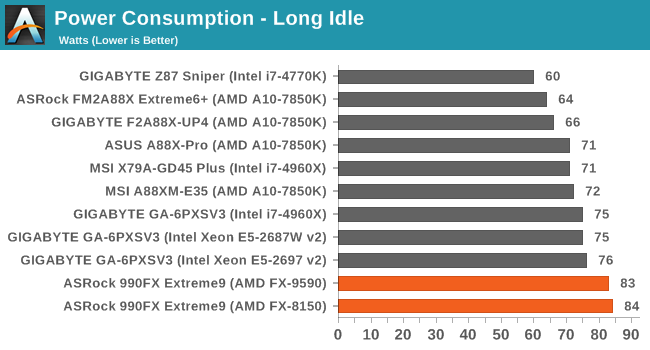
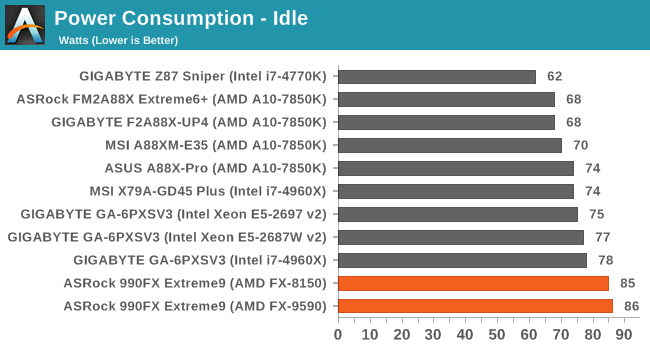
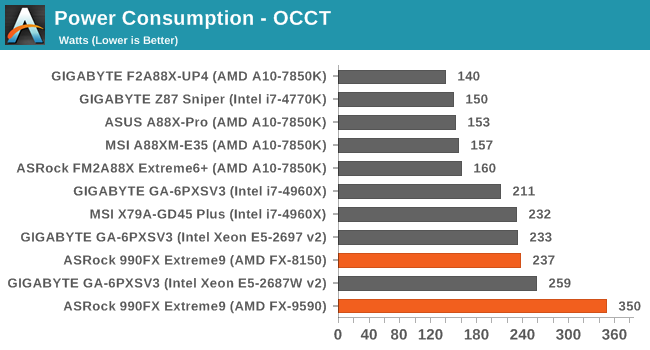
The added power draw of the FX-9590 is quite clear, showing 350W for the full system during a heavy CPU load. However, the idle power draw of the CPU is similar to that of the FX-8150.
Windows 7 POST Time
Different motherboards have different POST sequences before an operating system is initialized. A lot of this is dependent on the board itself, and POST boot time is determined by the controllers on board (and the sequence of how those extras are organized). As part of our testing, we are now going to look at the POST Boot Time - this is the time from pressing the ON button on the computer to when Windows 7 starts loading. (We discount Windows loading as it is highly variable given Windows specific features.) These results are subject to human error, so please allow +/- 1 second in these results.
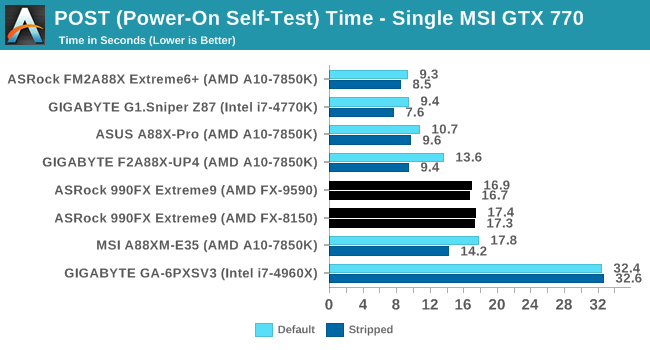
The FX-9590 afforded a shorter POST time than the FX-8150, although both are north of 16 seconds.
Rightmark Audio Analyzer 6.2.5
The premise behind Rightmark:AA is to test the input and output of the audio system to determine noise levels, range, harmonic distortion, stereo crosstalk and so forth. Rightmark:AA should indicate how well the sound system is built and isolated from electrical interference (either internally or externally). For this test we connect the Line Out to the Line In using a short six inch 3.5mm to 3.5mm high-quality jack, turn the OS speaker volume to 100%, and run the Rightmark default test suite at 192 kHz, 24-bit. The OS is tuned to 192 kHz/24-bit input and output, and the Line-In volume is adjusted until we have the best RMAA value in the mini-pretest. We look specifically at the Dynamic Range of the audio codec used on board, as well as the Total Harmonic Distortion + Noise.
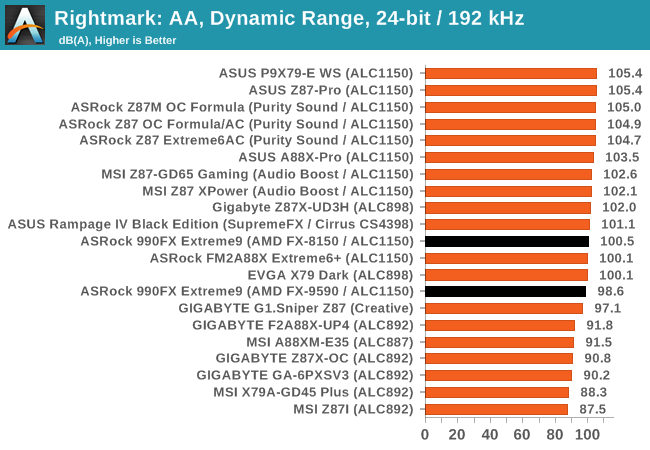
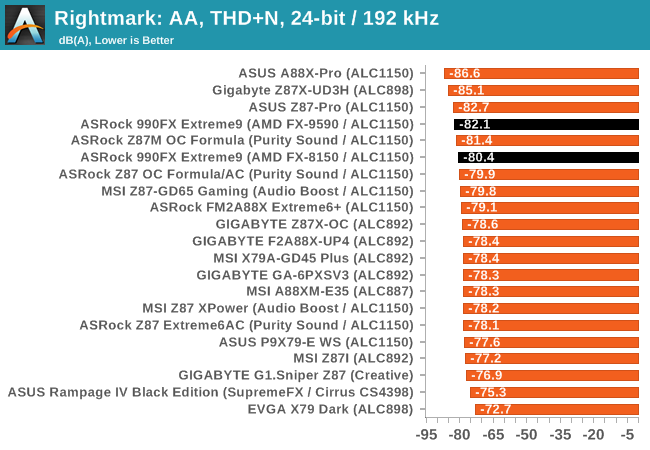
USB Backup
For this benchmark, we run CrystalDiskMark to determine the ideal sequential read and write speeds for the USB port using our 240 GB OCZ Vertex3 SSD with a SATA 6 Gbps to USB 3.0 converter. Then we transfer a set size of files from the SSD to the USB drive using DiskBench, which monitors the time taken to transfer. The files transferred are a 1.52 GB set of 2867 files across 320 folders – 95% of these files are small typical website files, and the rest (90% of the size) are the videos used in the WinRAR test. In an update to pre-Z87 testing, we also run MaxCPU to load up one of the threads during the test which improves general performance up to 15% by causing all the internal pathways to run at full speed.
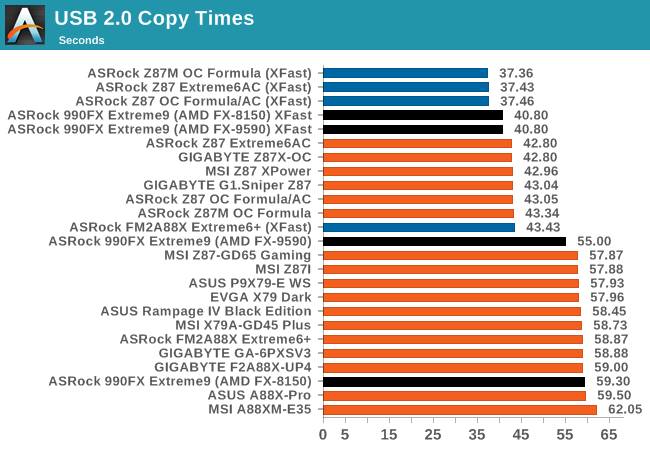
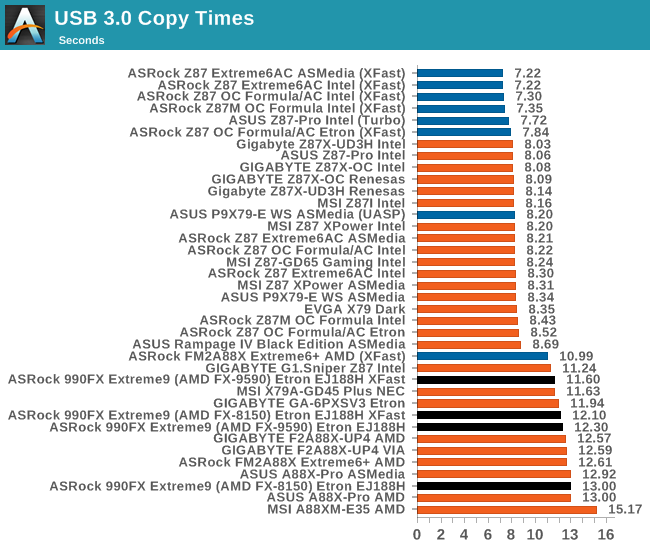
The increase in CPU speed of the FX-9590 gives a measured improvement in standard USB copy times – saving 4.3 seconds over the FX-8150 for USB 2.0 transfers. However using XFast USB eliminated that difference completely. For USB 3.0 transfers, using the Etron controller put a consistent advantage on the side of the FX-9590.
DPC Latency
Deferred Procedure Call latency is a way in which Windows handles interrupt servicing. In order to wait for a processor to acknowledge the request, the system will queue all interrupt requests by priority. Critical interrupts will be handled as soon as possible, whereas lesser priority requests, such as audio, will be further down the line. So if the audio device requires data, it will have to wait until the request is processed before the buffer is filled. If the device drivers of higher priority components in a system are poorly implemented, this can cause delays in request scheduling and process time, resulting in an empty audio buffer – this leads to characteristic audible pauses, pops and clicks. Having a bigger buffer and correctly implemented system drivers obviously helps in this regard. The DPC latency checker measures how much time is processing DPCs from driver invocation – the lower the value will result in better audio transfer at smaller buffer sizes. Results are measured in microseconds and taken as the peak latency while cycling through a series of short HD videos - less than 500 microseconds usually gets the green light, but the lower the better.
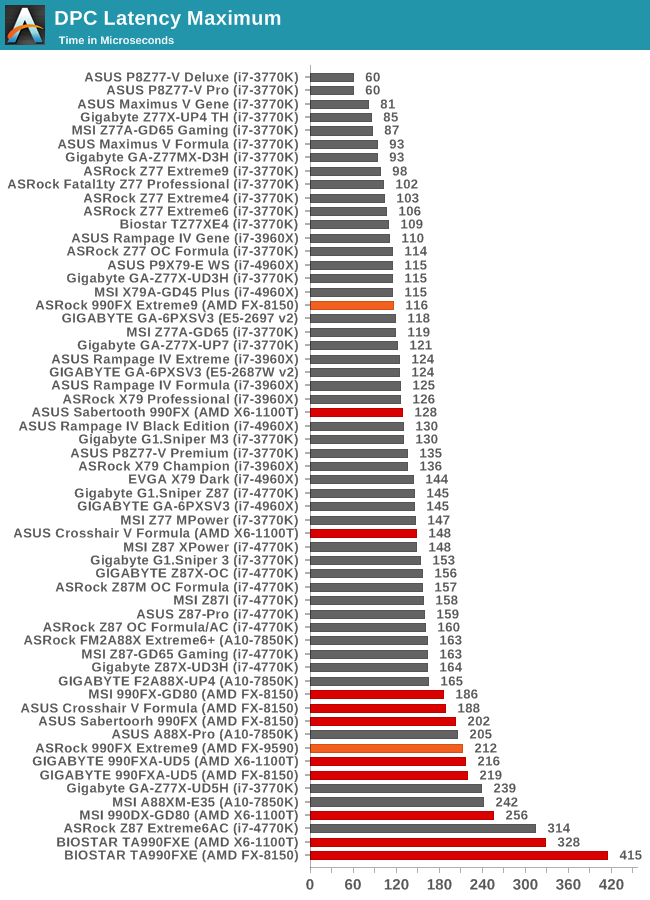
In a surprising twist, it would seem the FX-9590 has a disadvantage for DPC latency. I would have expected the faster processor to have the lower result, but one might speculate that the BIOS is tuned more for the mainstream processors such as the FX-8150. The chipset might also be geared more to the FX-8150 as it was the earlier generation compared to the FX-9590.










146 Comments
View All Comments
just4U - Sunday, August 10, 2014 - link
In my opinion the best cpu AMD has right now is A8 7600 coming in at $120 CAD. I see no reason to go Intel i3 as long as that puppy is there. (A argument can be made for Intel's AE 3x) The downside for AMD is I also see no reason why anyone should buy a more expensive CPU/APU from them.. their A-10 is priced in the same range as lower I5's which is a bit of a head shaker and their AM3+ is getting long in the tooth with no refresh.I could see a new FM2+ FX branded cpu priced at the tier their offering their A-10s for as it would bring something more to the table.. but they do really have to do something about single threaded performance. Even if it wasn't being used as much in programs their line-up takes a beating in reviews which is bad optics for them and leads to people like us (who read these things..) to suggest other alternatives for people buying/building a system.
FightApathy - Sunday, August 10, 2014 - link
237W operational power consumption. This is just.... terrible for a 2014 CPU. And what is even worse, is that i7 with 1/3 of TDP performs as well or even better. AMD has to stick to APUs.KAlmquist - Sunday, August 10, 2014 - link
"One could speculate that releasing the next generation of FX-85xx might put them behind the FX-9590 in performance, or that the fabrication process was not suitable for a quad-module CPU with the new architecture improvements."According to the Steamroller review, the 28nm bulk process that Steamroller was designed for won't clock as high as the 32nm SOI process that Piledriver uses. So an 8 core Steamroller processor would execute more instructions per clock, but would be clocked at least 400 Mhz slower, and as a result would be only marginally faster than Piledriver.
AMD is expecting to achieve another boost in instructions per clock with Excavator, but unless something has changed they plan to synthesize Excavator using software that minimizes die area at the cost of clock speed, so I'd expect Excavator to do more to improve performance per watt than to improve absolute performance.
After Excavator comes a completely new design, which we can hope will be a major improvement over the bulldozer derivatives.
mathewmichal7 - Sunday, August 10, 2014 - link
Draft your credit agreement is an excellent example of an innovative style of marketing. There is a provision for the lender to get cash advance check their debtors. He takes comfort in check on the day of your salary. Undoubtedly reduces the possibility of non-payment money and is beneficial for the creditor and the debtor. Delinquent and insolvent are not left disappointed by the money lenders. Your loan application forms become a matter of serious consideration if they manage to impress your money lenders for their current financial situation. The number of your credit profile does not control the situation and creditor left unchecked.http://www.12monthloansmoney.co.uk
duploxxx - Monday, August 11, 2014 - link
funny to read all these replies. makes you wonder what avarage age and technology knowledge is of these tech sites.....All complaining about useless AMD and process tech but yet they don't understand that these own consumers are the ones to blame, they buy the jingle and bells and the marketing buzz... recent review on anandtech showed enough what was best to buy, yet most decide to buy the other marketing dominant brand as if there all day tasks are faster since the benchmarks show few percentage faster finished task... buyers need to blame themselve for there own stupid decisions. Want a fast system? get rid of Microsoft garbage. OEM-marketing kill the competition and consumers are the victim but they still dont understand it. (useless chipset revisions, socket changes, design rules like in ultrabook space and centrino, etc, etc..). poor consumers.
From a tech site you indeed need to review such a CPU, its mandatory but i don't think it gets the honor for what it supposed to be, anyhow there will be only few to sell since it has no reason to exist becide the mythical part.
I remember the days of pentium D and extreme, no reason at all to exist yet 1000's of buyers just for the brand....
duploxxx - Monday, August 11, 2014 - link
since no edit button :) thx anandtech asking that already for more then 10yI meant age and knowledge of the readers of course
Klimax - Monday, August 11, 2014 - link
Lovely nonsensical post. Including out of date bashing of Microsoft. 90s called, they want your nonsense back.Mugur - Monday, August 11, 2014 - link
There is still room for AMD in my home. I have 2 SB Core i3s for the gaming machines and I've just replaced an 80W Phenom II HTPC with an Intel NUC 2820. But my server (currently an Athlon II X4) will be soon an A10-7800 at 45W on a FM2+ with 8 SATA board...jgarcows - Monday, August 11, 2014 - link
How did you manage to post a review of a chip with a bundled retail liquid cooling system and not post a single picture of the liquid cooling system? How easy was it to install, what size openings are needed on the case, etc...LemmingOverlord - Monday, August 11, 2014 - link
May I suggest:a) some impressions on the liquid cooling? (+pics)
b) underclocking the CPU (and lowering voltage), then map that to power v. performance curves for the same set of benchmarks you ran... just to see how big a drop it would be in wattage.